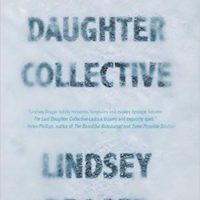The Lost Daughter Collective by Lindsey Drager is not subtly brilliant. Its brilliance washes over you in waves, again and again, immersing you in the text and giving you an experience of constant awe.
The novel—and despite its experimental style and organization, there is enough of a throughline to make the designation of “novel” entirely fair—starts out with a girl, the daughter of a “Wrist Scholar,” turning five years old. Her father enters her room at 1am to tell her a story. The story continues over an undisclosed number of nights, and concerns the fates of lost and dead daughters. The lost ones are nicknamed Alice, the dead ones Dorothy—referring to Alice of Wonderland and Dorothy of Kansas and Oz. The use of Alice and Dorothy creates a cognitive dissonance, as the world the novel inhabits is not necessarily our world, and so Alice and Dorothy as we know them may not exist yet, or may have never existed.
The first half of the novel chronicles the girl whose fifth birthday starts the book. The structure zigzags. We see the girl lose her baby teeth, become frightened by this loss, and create her own shadow puppet friends; we see her career as an Ice Sculptor (the capitals are Drager’s); we hear the Wrist Scholar’s stories about the Lost Daughter Collective, where men come together at the top of an umbrella factory to talk about their missing or dead daughters, their Dorothys and Alices. It sounds complex, but Drager makes it work. The Wrist Scholar’s stories are eerie and full of sympathy for the girls; the sense is that their fathers never quite understand them, even if they love them dearly. The fathers are protective to a fault, leading to their daughter’s loss or death in a roundabout way. But the power dynamic between the daughters and fathers is constantly shifting, often leading to the daughters taking power in their own hands.
The second half of the novel takes the first half and turns it into myth. It is as if the novel’s halves take place in a parallel universe—perhaps the one built by Ben Marcus in The Age of Wire and String, as Drager’s world shares a peculiarity of abstract language with that book: The Wrist Scholar is literally trying to prove that the wrist does not exists; Room Scholars are obsessed with the idea of containment, entrance, and exit; and the Ice Sculptor studies at the Multiversity.
In this part of the book, the Lost Daughter Collective leaves the realm of stories and becomes the driving force of the narrative. It is now called FOLD—the Fathers of Lost Daughters—and the fathers who belong to it tell their daughters stories about the Ice Sculptor, about her father who studied risk (implying that “wrist” got mangled over time). The fathers’ names are the same as the professions of the fathers in the stories from the first half of the book: The Barber, The Butcher, The Miller, The Woodsman, The Smith, The Angler, The Wainwright, and The Archivist. Their leader is “known only as Peter” and he bears a resemblance to Peter Pan, as Dorothy and Alice are connected to their respective stories. Each mini-story about a daughter is portrayed first as a cautionary tale and later as a reality. The two halves of the book mirror one another ingeniously, playing off the idea of the personal versus the mythical.
It would be easy to view The Lost Daughter Collective as an exploration of Freudian ideas about the connections between fathers and daughters. But the book goes further, into territory rarely explored in this format. In chapters titled “What Peter Thinks But Cannot Come to Say,” we’re given direct access to Peter’s thoughts.
That he [Peter] is ashamed. That he is ashamed to reveal his particular form of daughter loss because he lost only one iteration of his daughter, not the flesh being.
That the truth in its completeness is this: Peter’s daughter is now his son.
This revelation, and the way Drager continues to explore it in an alternate universe—writing about Body-Spirit Synthesis Disorder instead of gender dysphoria, and a Thought Doctor rather than a psychologist and/or psychiatrist—changes the novel. It’s an acknowledgment of a trans experience so rarely discussed in books about fathers and daughters or fathers and sons. Each of the novel’s halves has a satisfying and emotional ending that will leave a reader reeling for a while. This emotional quality is a wonderful payoff to the rest of the book, which is so often cerebral.
The Lost Daughter Collective is truly brilliant, on so many levels, and Drager continues to be a force and should be recognized widely for her work.




